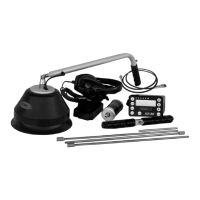
Do you have a question about the Fisher Labs XLT-30 and is the answer not in the manual?
| Brand | Fisher Labs |
|---|---|
| Model | XLT-30 |
| Category | Security Sensors |
| Language | English |
Benefits and safety precautions for using headphones with the XLT-30.
Describes the control box housing all listening and filtering controls.
Explains the Big Foot Sensor for hard surfaces and its mute function.
Details the Little Foot sensor for confined areas and its mute activation.
Describes the Multi-Sensor's superior leak detection capabilities and versatility.
Explains the Hydrophonic Cylinder Probe for direct contact and pipe noise listening.
Describes the two sizes of sound rods for direct or indirect contact to pipes.
Explains the T-Handle's primary use with the Cylinder Probe and sound rods.
States the handle used with the Multi-Sensor.
Details the headphones' design for clear sound and volume adjustment.
Explains how the probe cable attaches to the control housing and various probes.
Describes the attachment system for the XLT-30, including the mounting bracket and strap.
Explains the POWER pad for turning the XLT-30 on/off and reset behavior.
Describes the LIGHT pad for turning the backlight on/off.
Details how to adjust headset volume using the VOLUME pad and arrow keys.
Explains the NOTCH control for masking or rejecting a specific range of frequency response.
Introduces the FILTER modes and the 'AL (All Frequencies)' mode.
Describes the HI filter mode for adjusting response in higher frequency areas.
Explains the LO filter mode for listening to lower frequency areas.
Details the FC filter mode for tuning to specific frequency bands.
Explains the HOLD/MUTE button for muting audio and resetting peak hold.
States that arrow keys modify XLT-30 features.
Describes the RESUME pad to return to the sound graph display after modifications.
Step-by-step guide for assembling and preparing the XLT-30 for operation.
Guidance on adjusting filters during a leak search for better detection.
How to use the notch filter to eliminate masking sounds.
Details on using the Multi-Sensor for various surface conditions.
Instructions for connecting the multi-sensor with T-Handle and sound rods.
FCC compliance statement and measures to correct radio interference.
Specifies the operating frequency range and gain levels of the XLT-30.
Lists and describes available filter types and their frequency ranges.
Details the audio and visual output indicators of the XLT-30.
Specifies splash-proof rating, battery test, type, quantity, and life.
Lists the weights and accessories included with different XLT-30 options.
Lists the standard equipment provided with each XLT-30 option.
